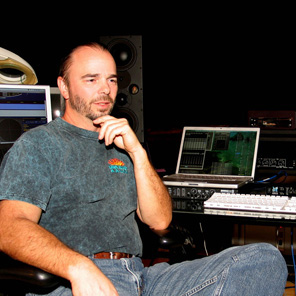|
 Ed Abbott Ed Abbott
HOLLYWOOD, CALIFORNIA: Universal Mastering Studios - West (UMS-W) has fully reopened for business following its relocation from North Hollywood to the historic former Hanna-Barbera animation studios building in Hollywood. In the process, the facility's services have expanded to encompass a main mastering room and five production rooms, plus space for expansion into other areas of work, with every room outfitted with either Metric Halo interfaces or the company's OEM units supplied by mastering specialists Sonic Studio.
While handling mastering projects for Universal Music Group, as well as other A-list clients, UMS-W principally focuses on restoration and archival services for the company's vault. In the largest of the five production rooms, Ed Abbott - technical engineer and R&D specialist - handles archival projects with a personal collection of equipment that includes a pair of Metric Halo's latest ULN-8 interfaces, plus a custom-made mastering input unit based on the Mobile I/O ULN-2 with an integrated custom analog front-end and 2d upgrade.
As the front-end of the music vault, Universal Mastering Studios has a tremendous responsibility to honor the company's musical legacy," says Abbott. "I've always been looking for the best of all possible signal chains. In doing archival transfers I came across some absolutely spectacular first generation tapes - quarter-inch, 15 i.p.s., non-Dolby - of Jimmy Buffett's album, A White Sport Coat and a Pink Crustacean. We used those as a benchmark to test A-to-D converters. Most of the current crop of best-in-class converters sounded great, but each traded transparency for it's own distinct color. It didn't take long to conclude that the only thing that really did the tapes justice, from an archival standpoint, was the ULN-8."
Abbott recalls how his initial production prototype ULN-8 set a new benchmark straight out of the box. "The top-end extension, the linearity, the transient response and the low-end (especially!) out of the ULN-8 made our other converters sound like you had earmuffs on. No lie, our first reaction auditioning the ULN-8 against our previous reference a/d was that something had gone wrong with the reference box. We'd spent years testing each new converter and were perfectly satisfied with our chosen reference, but the ULN-8 just immediately blew it out of the water. I was expecting it to be good, but I was completely unprepared for a multipurpose single rack-space unit to sound like this does. It goes down forever, goes up forever, and there's absolutely nothing in the way between the tape and what you're hearing," he enthused.
That said, the DSP inside the ULN-8 offers a wealth of possibilities. "One of the little tricks I've come up with is a parallel up-compressor run in DSP that uses EQ, the Metric Halo compressor and limiter, and M-S splitting," Abbott shares. "It only takes the low dynamic range stuff, the "least significant bits," - 60 dB or so, and pushes it, flavored, back into the main signal. On a clean source it will give you all sorts of detail that usually gets lost when you apply production limiting, bit down-conversion and lossy codecs."
That's a tip that Abbott has passed along to mastering engineers Erick Labson and Peter Doell. In addition to the newly relocated Hollywood center, Universal Mastering Studios includes a mastering/mixing room in Santa Monica, California; a New York facility housing four master studios and a production room; and the DISA tracking, mixing and mastering facility in Monterrey, Mexico. "We have Sonic Model 304s [OEM ULN-8 interfaces without mic preamps] in the main mastering rooms here and in Santa Monica. They're the centerpiece," Abbott says. The other production rooms at UMS-W house Sonic Studio Model 302 interfaces, the OEM version of the Metric Halo ULN-2.
The company's commitment to Metric Halo is not limited to hardware, notes Abbott. "Every room here has SpectraFoo. We all run Phase Torch with the level meters and spectral analysis tools." Abbott, who has worked at UMS-W for over fifteen years, reports that the test tones on archived tapes rarely offer accurate azimuth information compared to the music program, making Phase Torch invaluable. "We've found practically none of these tapes, especially the ones that had been edited, have the same azimuth all the way through. With Phase Torch running you can monitor azimuth on the music signal as you're going along, and you just edge it back in as it drifts. When you get severe azimuth shifts across tape edits you see it immediately and can adjust, recapture and assemble a completely azimuth-corrected archival master."
Having observed the importance of fast transient and small signal information to the quality of audio during his early experiments with SACD, Abbott comments that he was able to offer Metric Halo some suggestions during the development of the ULN-8 converters. "I was admonishing Joe and BJ [Buchalter, Metric Halo's founders] to concentrate on speed; make the converters as fast and as phase accurate as is humanly possible. That's what they did and that's why Character works so well. I mean, not every job benefits from complete transparency. Some sources are dull or dry and need a little help, and when you need the extra color of a tube or transformer stage, it's available." Metric Halo's Character processing engine allows users to selectively add the euphonic, low-order distortions found in classic analog devices. "Character is so cool, because it has all of the good stuff and none of the bad. Who ever heard of noiseless, phase coherent non-linear distortion? To the best of my knowledge it's never been done!" says Abbott.
He concludes, "I can't stop gushing about the Metric Halo stuff because it's the only gear that has ever not only lived up to all of my expectations but surpassed them in every way. Every day is a learning experience with this stuff." |